There are times when being the first person with a new gadget will elicit cheers and envy — like outside New York’s Fifth Avenue Apple Store, surrounded by applauding salespeople, curious fans and gawking media.
Then there’s buying the Amazon Fire Phone.
Marlena Solomon learned first-hand the hazards of being an early adopter when she jumped at the chance to buy Amazon’s first-ever smartphone a year ago.
Her excitement quickly turned to frustration after she realized the phone didn’t have many of her favorite apps — including Google Maps and Starbucks — and she was annoyed at how difficult it was to import her Apple iTunes library. On top of that, instead of marveling at her new gizmo, some people asked, “Why did you buy that?” Three months after she got the device, it went back in its original box and was tucked away at Solomon’s home. She went right back to owning an Apple iPhone.
“It’s the one time being a first adopter really kicked me in the butt,” said Solomon, 45, a marketing specialist for an automotive lubricants company who lives northwest of Houston. “As soon as I put it back in the box and charged up my iPhone, I didn’t think about it again.”
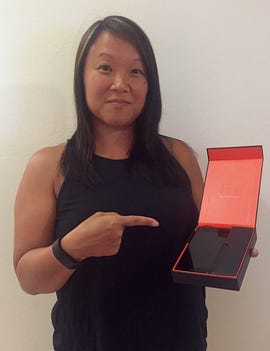

Courtesy of Marlena Solomon
Solomon’s experience is just one of the many negative reactions to the online retailer’s smartphone, which first hit the market a year ago this weekend. It became an uncharacteristic and high-profile failure for a top tech company known for thrilling customers and boldly expanding into new markets. The Fire Phone also serves as a warning to other would-be phone makers as proof that the smartphone market is incredibly difficult to break into, and offers lessons on what sort of pitfalls to avoid.
“I think the silver lining, if there is one,” Baird analyst Colin Sebastian said, “is that Amazon learned a lot about mobile and that everything they do won’t be a success.”
It’s a far cry from a year ago, when CEO Jeff Bezos took the stage at an event, held in Amazon’s hometown of Seattle, that was electrified by the excitement of the super fans the company had invited to sit alongside industry and media folks.
“Can we build a better phone for our most engaged customers? Can we build a phone for Amazon Prime members?” Bezos asked before taking a dramatic pause. “Well, I’m excited to tell you that the answer is yes.”
Amazon declined to make any executive available for this story.
It didn’t take long for reality to take hold and for the Fire Phone to flame out. Within two months, AT&T dropped the price from $200 to just 99 cents with a two-year contract. (It can be had for $179 without a contract.) Three months after the launch, Amazon took a $170 million charge to wipe out the lost value of its unsold Fire Phones, adding that it still had $83 million in inventory at the end of that period.
But the Fire Phone wasn’t a complete bust. For anyone looking to get into the smartphone business, the device offers a few critical lessons.
It’s all about price
There are a handful of reasons the Fire Phone flopped, but its starting price proved a major snag and may have turned off many potential customers.
Consumers and analysts were expecting Amazon to follow its familiar playbook of offering a cheap, but good-enough product that could undercut other devices already on the market. That strategy proved a success for Amazon in tablets, as its inexpensive plastic-and-glass Fire devices (originally the Kindle Fire) offered a cheap alternative to Apple’s iPad and helped Amazon become a major player in that market four years ago.
A closer look at the Amazon Fire phone (pictures)
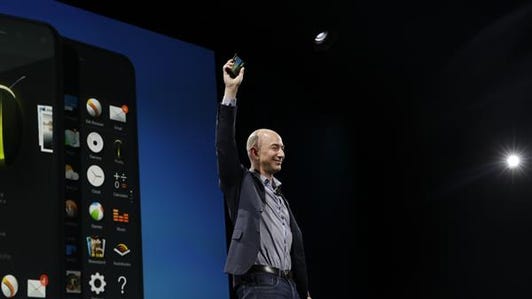

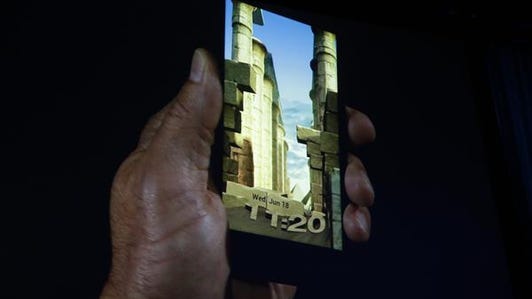



Instead, Amazon opted to create a top-shelf smartphone with high-end components that pushed its off-contract price to $650. If you signed a contract, the price dropped to $200.
All of a sudden, it became another flagship smartphone in a market overflowing with similarly priced flagship smartphones.
“That soured a lot of people,” IDC analyst Ramon Llamas said of the initial price.
Make the features count
Two of the Fire Phone’s differentiating features were 3D graphics, accomplished with the help of four front-facing cameras, and Firefly, a function that allowed people to scan and identify thousands of items, including products, songs and bar codes.


CNET
Neither was a hit with customers.
The 3D effect was at best a party trick. “Nobody cared about that,” said Gartner analyst Ken Dulaney.
Firefly, meanwhile, was seen by many as a cynical attempt by Amazon to get Fire Phone users to buy more goods from the e-retailer. But if that was the intent of Firefly, it didn’t work, since people tend to browse for products on their phones but typically complete purchases on a laptop or personal computer.
Overall, the Fire Phone was really only effective in differentiating itself in negative ways, Dulaney said.
Don’t be different (unless you’re Apple)
Amazon’s Fire tablets have run off a heavily customized version of the Android operating system software, which meant they didn’t have access to key Google apps like Maps or Gmail. So when it came time to make a Fire Phone, Amazon pursued the same strategy.
Turns out, people like those Google apps.


Justin Sullivan/Getty Images
“There were too many negatives in my mind to keep the Fire Phone or give it a try,” Solomon said.
By not embracing the Google-approved version of Android — which is what Samsung, HTC and most other smartphone makers use — it offered a third option it called Fire OS. But in this market, if you’re not using Apple or Android, customers don’t care. As of the first quarter, Apple’s worldwide smartphone market share was 18 percent, while Android’s was 78 percent, according to IDC.
That leaves the remaining 4 percent for the likes of Microsoft and BlackBerry to fight over.
Having sufficient market share is critical because it spurs developers to build apps and games directly for your platform. David Limp, Amazon’s senior vice president of devices, said in an interview a year ago that he hoped to convince developers to come aboard by making its Fire OS a place where they could generate more money from their work. He touted the hundreds of millions of active and engaged Amazon shoppers as another lure.
Exclusivity deals don’t work
While Amazon was marketing the Fire Phone to all of its Prime customers, the reality was it could only sell the device to anyone willing to sign up with AT&T. That’s because Amazon struck a deal with the carrier in exchange for marketing and retail support — a move commonly made by lower-profile vendors looking for assistance in building awareness.
But Amazon boasts a strong brand, particularly in the US, where the Fire Phone launched. The company had the benefit of featuring the smartphone on one of the largest online storefronts in the world. So why a deal with AT&T? The carrier got to Amazon early.
MORE ON THE FIRE PHONE
- Amazon’s gutsy phone fails to ignite (review)
- Amazon takes $170M charge on Fire Phone
- Amazon Fire Phone: Was $200, now just 99 cents
“We brought them an early prototype of the phone three years ago, and explained what we were trying to do,” Limp had said. “They were unbelievably excited.”
AT&T worked to optimize the Fire Phone’s features to better run on its cellular network, and promised Amazon the “flagship” spot for the 2014 fall season. Ralph de la Vega, then CEO of AT&T’s mobility division, came on stage with Bezos to praise the device: “This is an amazing, breakthrough innovation,” he said.
It wasn’t amazing enough.
Never again?
Amazon is just one of the companies smarting from its attempt to breach the smartphone business. Facebook attempted to dominate smartphones with its own user interface that wrapped around Android, but it too met with a similar cold reception.
“My view is the phone was largely doomed out of the gate,” Baird’s Sebastian said of the Fire Phone.
So will there be a sequel Fire Phone? Amazon has long shown a willingness to spend in search of new growth opportunities, from streaming TV shows to delivery drones to cloud-computing centers. But, the company now is signaling to Wall Street that it will work on cutting back its heavy spending. In this scenario, it’s not a stretch to imagine that the Fire Phone — one of the company’s biggest flops in years — won’t return.
Fire phone Dynamic Perspective gestures (photos)
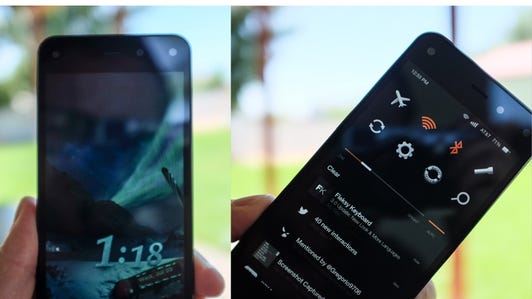

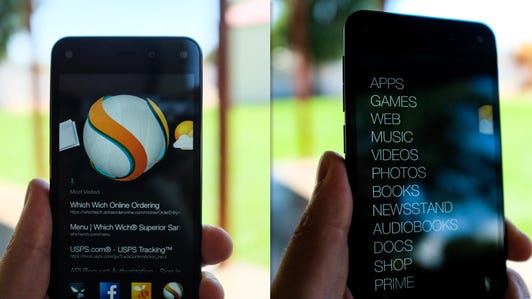



If there are any plans for a new Fire Phone, Amazon is mum about them. “We have a policy of not commenting on our road map, so can’t give you anything there,” Chief Financial Officer Brian Olsavsky said on the company’s quarterly conference call on Thursday. “We obviously do learn from everything we do and value the feedback we get from customers, but nothing to share at this point.”
Amazon has clearly gotten over the disappointment. The company on Thursday posted a surprise profit in the second quarter, leading to its share surging 17 percent in after-hours trading.
Back in Texas, Solomon is still unhappy with how things turned out for her. She hasn’t gotten around to returning her Fire Phone, so she still has to pay for the hardware every month, with $324.91 still left on her installment plan as of last month.
Solomon said it was unlikely that she would renew the Prime service she got with the phone.
“Honestly,” Solomon said, “I would probably not buy another piece of Amazon electronics because of my experience with the Fire Phone.”


Now playing:
Watch this:
Amazon’s own food brand may be coming soon
2:06



